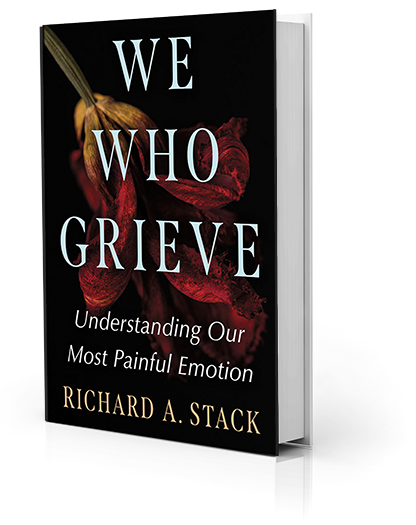Home > Resources > Richard A. Stack | We Who Grieve: Understanding Our Most Painful Emotion
We Who Grieve: Understanding Our Most Painful Emotion
by Richard A. Stack
Richard A. Stack, associate professor emeritus, taught for three decades in the School of Communication at American University. He has published four books and is an award-winning documentary producer. He volunteers at Washington, D.C.’s leading grief counseling center.
Excerpt
Hospice Workers
Those who engage in end-of-life hospice care—doctors, nurses, social workers, volunteers—have much to teach mourners and those who soon will be bereaved. There are few fields so immersed in death and dying. These professionals have heard all the usual questions: Why would anyone choose to do hospice work? Why would someone opt to spend their career so deeply entangled with dying-induced grief? How is it possible to get up the next morning and do it all over again?
As intense and exhausting as the work is, one rarely hears hospice professionals complain that their jobs are disheartening. Rather, they’re likely to describe their work as fulfilling. It may seem counterintuitive, but “life-affirming” often is used to explain what they do. Annual turnover rates at hospice facilities are surprisingly low. Hospice centers are wary of employee burnout and are on guard against “compassion fatigue.” With more Americans choosing hospice care, maintaining a dedicated, rejuvenated workforce is a constant concern. According to a report from the Medicare Payment Advisory Commission, the number of hospice patients grew 167%, to more than 1.4 million, between 2000 and 2016. Nearly half the Medicare beneficiaries who died in 2015 availed themselves of hospice services.
By standard medical measures, hospice doctors might be considered failures. Depending on the size of their facility, such personnel could lose up to two dozen patients a week. But those who work in hospice care do not assess themselves by the binary metrics of life or death. In their professional capacities, death is constant, unavoidable, inevitable.
While they know there is little they can fix at the end of life, hospice professionals are sustained by the belief that their work is sacred. These caregivers evaluate their performance by how well they guide their patients to their end. They know that the most they can do is give their patients an opportunity to have the best deaths possible. That may mean a pain-free death and for the fortunate a death free of distress. While most people run away from death, hospice workers rush toward it. They carry with them the knowledge that they know what their patients are going through and the attitude that they are there to help.
There is a shortage of hospice care in the United States. There are too few doctors and nurses to keep up with an aging population, especially in rural areas. Many facilities are understaffed, particularly those providing home care. It is not unusual for a hospice center to conduct extensive fundraising to supplement Medicare to be able to offer additional services such as music and art therapy.
The easier task for a hospice professional is relieving a patient’s physical symptoms. Medication can control pain and agitation. Much of death, however, is not medical. Many in the field believe that their more daunting challenges are spiritual and psychological. Hospice workers know they cannot smooth over all slights or eliminate all resentments. But often they do try to facilitate discussions that result in deathbed reconciliations.
The prevailing attitude of hospice care providers seems to be that they get more from their work than they give, and they give a lot. It is thought that the work is a way for them to sync their soul with their role. Common takeaways for those engaged in this work are learning not to hold onto resentments and making the extra effort to find joy in the everyday.
Knowing they can positively influence the end of their patients’ lives carries care workers forward. They lean into the challenges, knowing that their presence makes a difference. They hold their patients’ hands with a sense of honor. The hospice worker helps the patient find peace and comfort and in so doing upholds the dignity of that patient’s life. All the while, the hospice professional may be learning not to fear death.
Hospice workers may or may not be religiously observant but generally think of themselves as spiritually inclined. The job may confirm one’s faith while challenging one’s beliefs. This is especially so when a caregiver witnesses a patient suffering. That’s when the work requires something extra, be that prayer or meditation or nature.
Those in the field need to be intentional about self-care. They must find ways to replenish themselves to stay mentally engaged in their work. It is critical that care providers not suppress their feelings. It is important that they develop ways to process and share their emotions with others. A primary risk is compassion fatigue, numbing to the suffering of others. This is a sensation that caregivers may experience. The indicators are increased irritability, dread of going to work, and inability to experience joy. Malaise can be accompanied by substance abuse. Characteristic of compassion fatigue is use of depersonalized language as when a care worker refers to a patient by diagnosis instead of name.
Coping mechanisms caregivers use include yoga, stretching, and other stress-reducing exercises. Hospice employees are encouraged to find peers in whom they can confide. Staff often develop their own activities to acknowledge the meaning of their work, such as ceremonies to honor the lives and memories of their patients.
We Who Grieve: Understanding Our Most Painful Emotion © 2024 Richard Stack by permission of McFarland (McFarlandBooks.com).

